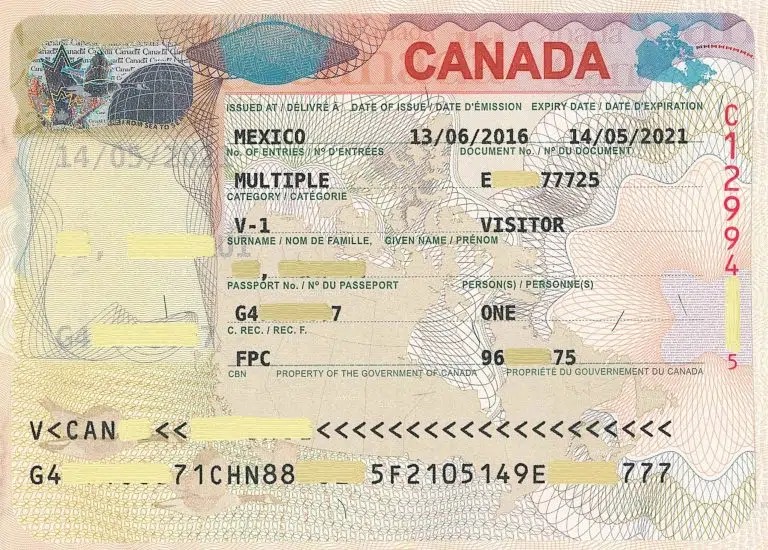Information About Visas to Work, Study or Travel Abroad
What is a visa?
A visa is an official travel document allowing a foreign national to enter, stay and leave a country within a specific period. There are many different types of visas, including transit visas, visiting visas, and work and study visa. Each type of visa has its requirements and conditions. For example, a transit visa requires that the applicant have a valid passport and proof of onward travel.
Sample of a valid travel visa

As shown in the Canada visa sample image above, a valid travel visa usually contains a visa sticker, your travel document (e.g., passport), your name, your picture, the visa duration, or how long you can stay on single or multiple entries, and other information such as the issuing country and Embassy or Consulate where you applied for the visa.
A work visa may require the applicant to have a job offer from a sponsoring employer, while a student visa may require the applicant to be enrolled in an educational institution. The specific requirements depend on the type of visa and the country issuing it, and visa applications may be made online, at a consular office, or an embassy. Some eTA visas may be obtained at the airports; some countries also offer visas on arrival to citizens of eligible countries.
A Story About Travel Visas
There was a time, long ago when people could travel freely from one country to another without any restrictions. However, as the world grew more and more interconnected, it became clear that something needed to be done to regulate the movement of people. Thus, the travel visa document was born in 420 BC. Specifically, the first visa was issued to Nehemiah in the Hebrew Bible during a travel passage to Judea of Jerusalem.
Other notable events in the history of travel visas and permits:
- 1386 – 1442: The first passport was created by King Henry V.
- 1643 – 1715: King Louis XIV of France signed travel documents he called “passe port.”
- 1918 – onwards: Passports became an obligatory document post-First World War.
- 1922 – 1938: The League of Nations in Paris launched the “Nansen Passport“ to reduce refugees after WWI.
- 1945 – onwards: All kinds of travel documents (passports, permits, work and study visa, and border patrol) became mandatory after WWII.
Over the years, there have been many changes to visa regulations worldwide. In some cases, certain countries have made it more difficult for people from other countries to enter; in others, visa requirements have been relaxed to promote tourism and trade. But one thing has remained constant: the travel visa is vital to global immigration policy.
What is a visiting visa?
The visitor visa (sometimes called a tourist visa or visitor’s visa) is a type of visa that allows a foreign national to enter and stay in the country for a temporary period. Visitor visas are typically used for business, tourism, medical treatment, short courses, leisure, or visiting friends and family.
Visitor visas are generally valid for six months or one year but can be extended if necessary. To apply for a visitor visa, you must provide evidence that you have strong ties to your home country and will leave the country once you visit.
What is a work visa?
A work visa is a government-issued permit that allows someone to take up paid employment in a foreign country. The requirements for obtaining a work visa can vary depending on the country. In some cases, employers may need to sponsor their employees for a work visa, while in others, individuals may need to apply for one themselves.
Work visas usually come with certain restrictions, such as only being valid for a specific period of time or only allowing holders to work in specific occupations.
What is a study visa?
A study (or student) visa is a document permitting a foreign national to enter and stay in a country to study at an accredited educational institution. Generally, to get a student visa (study permit), you must be accepted by a school, college, university, or other accredited educational institution in the country.
An important requirement to apply for a student visa is proof that you have enough money to pay for your tuition and living expenses while enrolled in school. Some countries allow international students to work part-time while they study, usually 20 hours per week.
What is immigration?
Broadly speaking, immigration is the process or act of relocating to live in a foreign country. This can be either for a temporary period or on a more permanent basis.
When people talk about immigration, they often mean the kind of permanent movement that results in someone settling in a new country, and Immigration usually involves obtaining some permission from the destination country’s government. For example, people who want to move to the United States must obtain a green card, which grants them permanent residency status.
*#################*
*WELCOME TO UNCLE NE’S NEWSPAPER www.unclene.com*
*FOR JOB SEEKERS ON WHATSAPP, CLICK ON THIS LINK TO JOIN FOR DAILY JOB UPDATES:*
https://chat.whatsapp.com/GdAMPPYCfPsBelEYFHLpg8
*Uncle Ne’s Job Group in Telegram with over 4870 members … when you join 500 previous jobs are sent to u:* https://chat.whatsapp.com/GdAMPPYCfPsBelEYFHLpg8
Related posts:
*300 Fully Funded Gates Scholarships 2026 in the USA*
*Harvard Environmental Fellows Program 2026 in USA*
*1500 scholarships available opportunities, and Cameroon is eligible, many have been succeeding, Unc...
*Fully Funded Scholarships 2025 at UNIMORE, Italy*
*FCNY Community Planning Fellowship Applications Close June 9, 2025*
*Science & SciLifeLab Prize 2025 for Young Scientists*
*German Bonn International Fellowships 2025 Inviting Applications*
*National Higher Education Scholarship 2025 at Semmelweis University Hungary*
*SFR2CC Project Scholarship 2025/2026 at Kabale University*
*Moroccan Government Scholarships 2025 Open for International Students from Multiple Countries*
*Artificial Intelligence BSc Scholarship 2025 at University of Bradford*
*Telesat’s Women Scholarship 2025*
*Apply for ‘Study in Germany’ Ambassador Program 2025*
*Otsuka Toshimi Fully-funded Scholarship 2026 at APU Japan*
Multiple *US Embassies Inviting Applications for Fulbright Foreign Student Program 2026–2027*
*Fulbright Foreign Student Program for the 2026–2027 academic year is now officially open in several...
Discover more from UNCLE NE JOBS
Subscribe to get the latest posts sent to your email.

